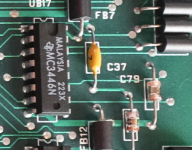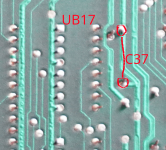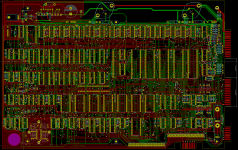johnq
Experienced Member
I'm busy with a project to, as close as possible, recreate the PCB layout from scratch for the Commodore PET Universal 8032086.
About 95% completed and have been using the schematic diagrams and hi-res pics of the motherboards to re-create the PCB layout.
During the reverse engineer I've found what looks like a few design faults.
Is there someone with a 8032086 and a multimeter that can take 2 continuity tests for me.
1) Test across C37 - on the PCB looks like this component is shorted with traces. (Not a big deal as it's a decoupling cap)
2) Measure from UB17 (MC3446) to ground. On the schematic this shows it's connected, but I can't see it connected on the PCB. I can't how the PET works without this connection so there must be a connect to ground I'm just not seeing.
Both components are top right, next to each other.
About 95% completed and have been using the schematic diagrams and hi-res pics of the motherboards to re-create the PCB layout.
During the reverse engineer I've found what looks like a few design faults.
Is there someone with a 8032086 and a multimeter that can take 2 continuity tests for me.
1) Test across C37 - on the PCB looks like this component is shorted with traces. (Not a big deal as it's a decoupling cap)
2) Measure from UB17 (MC3446) to ground. On the schematic this shows it's connected, but I can't see it connected on the PCB. I can't how the PET works without this connection so there must be a connect to ground I'm just not seeing.
Both components are top right, next to each other.




